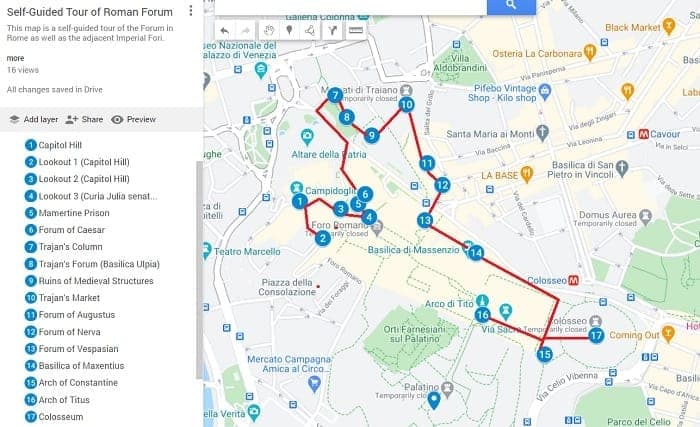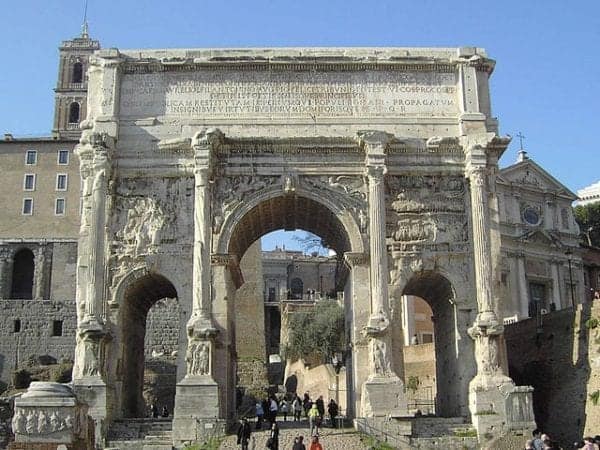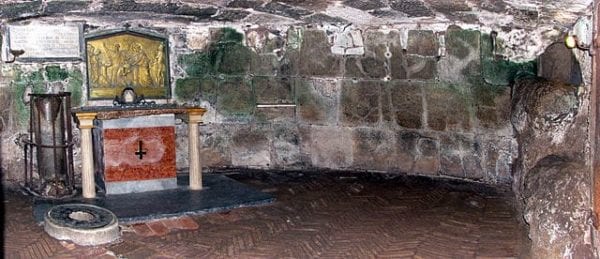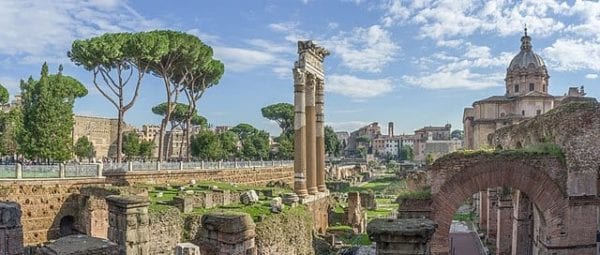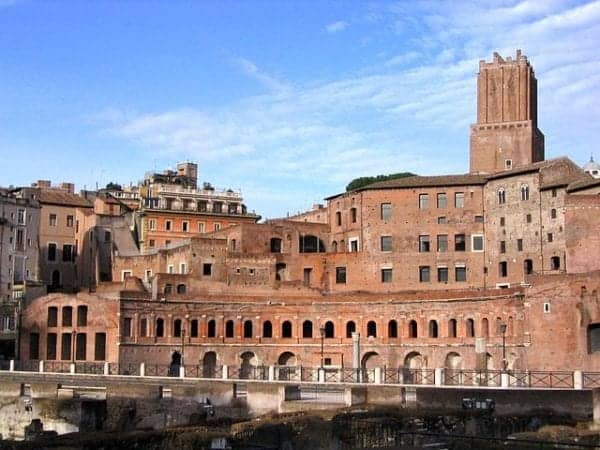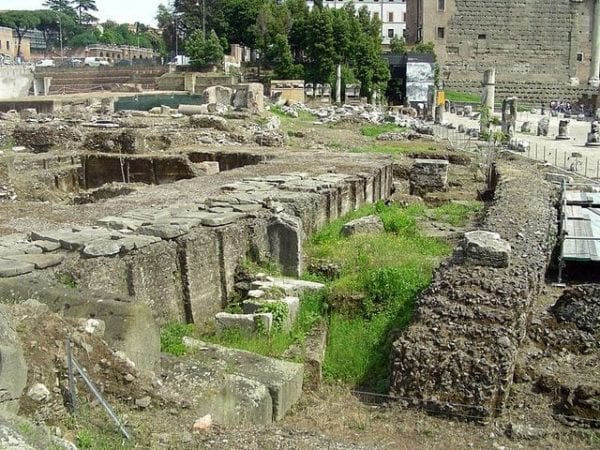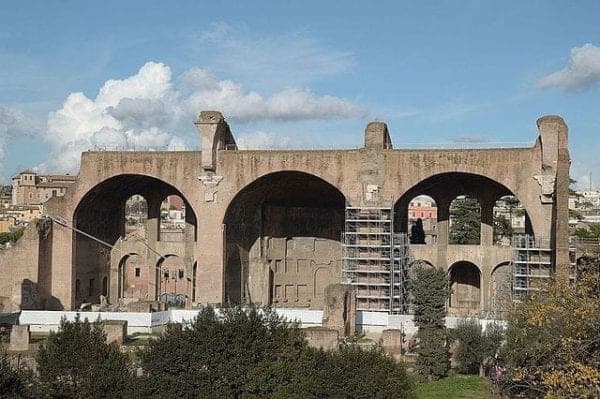This post is a self-guided tour of the Forum in Rome as well as the adjacent Imperial Fori.
The tour should take approximately 1 hour or just a bit less than that. The walk is approximately 1 km (just over 1/2 a mile).
This walk is an abridged version of our Ancient Rome audio tour. Listen to a sample of the tour.
There is no schedule (take our tours anytime you wish). We also have an audio tour of Central Rome.
- Purchase this audio tour from our Booking Page (scroll down to Rome)($2.99/download).
- You’ll receive a confirmation email with a .pdf, Google Map link, and audio tour.
- Enjoy the tour(s).
There are also free guided walks that usually take place multiple times each day as well as tours that cover Central Rome, Vatican City, and the Colosseum.
Searching Availability...
The tour begins from Capitoline Hill (map). It is within walking distance of many historic Rome sites.
Click on the map to enlarge it or to download it to a smartphone.
We have 4 other self-guided tours that we hope you will consider.
Capitoline Hill/Piazza del Campidoglio
This location is filled with historic sites, including Piazza del Campidoglio itself, which was actually designed by Michelangelo.
Originally, this was one of the seven hills upon which Rome was built, and it was the center of civic life in the city for many years.

Today, the hill is home to many notable sites including the Palazzo dei Conservatori, the Palazzo Senatorio, the Capitoline Museums, and the Basilica di Santa Maria in Ara coeli.
There are also a few notable sculptures and fountains in the area, including Lupa Capitolina and Fontana della Dea Roma.
Overlook of the Roman Forum
You’ll find this overlook past Palazzo Senatorio, to the right, and past the arch on Via del Campidoglio.
This is one of the best places to get a good view of the Roman Forum, with several great examples of architecture that relied heavily upon the use of white marble and columns.
The Roman Forum was the first fora in this area, and during the era of the Republic, it was the only centre for civic life in Rome.
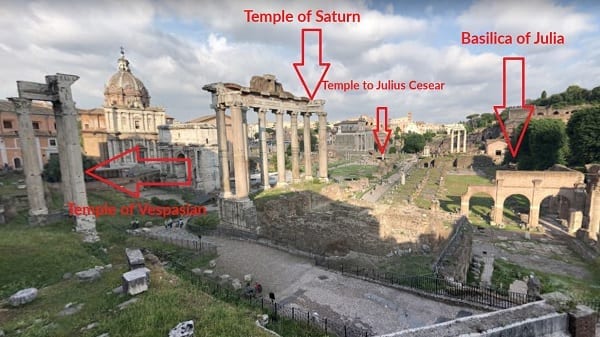
If you look directly ahead from the direction in which you came, you’ll see three columns that are remnants of the Temple of Castor and Pollux.
To the left of this site, you’ll find the Temple of Saturn represented by its eight remaining columns.
This was built shortly after the Temple of Jupiter, which makes it the second-oldest remaining temple from the Republic era.
You’ll find The Temple of Vespia right next to the Temple of Saturn.
Between the Temple of Saturn and the Temple of Castor and Pollux, you’ll also see the Temple of Antoninus and Faustina.
To the right of this site is the Temple of Julius Caesar.
Second Overlook of the Roman Forum
To reach this location from the last overlook, head back to Piazza del Campidoglio and turn right. D
Once you pass the palace, turn right again on Via di San Pietro in Carcere. The overlook is straight ahead and down the stairs.
On the far right, you’ll see the back of Palazzo Senatorio.
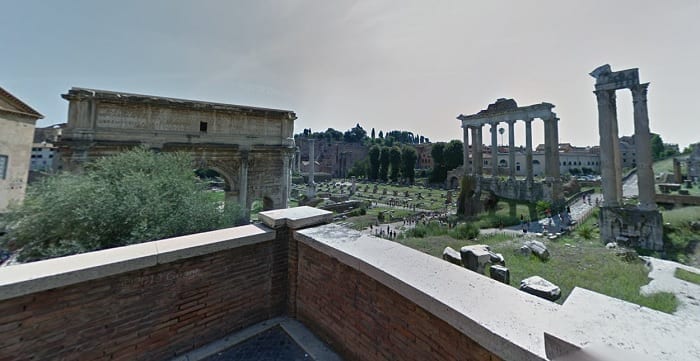
This part of the building was constructed over the old Temple of Veiovis, and it was used for the Tabularium (records office).
From the base of the wall here, you’ll see a few small ruins from the Temple of Concordia, a location that was once used for Senate meetings.
The irony is that Concordia was the goddess of harmony, and not every meeting which took place here was harmonious.
After all, this is where Cicero gave the last of many speeches that condemned a fellow senator’s plot to overthrow the Roman government, which resulted in his opponent receiving the death penalty.
On the left, you’ll see the remains of the Rostrum, a speaking platform that was used for public addresses.
You’ll find the Arch of Septimius Severus next to this landmark.
This is just one of many triumphal arches which commemorate the victories of famous Roman leaders, each part of a processional route used during Roman triumphs. We’ll be visiting a few more on this tour.
The next overlook is on the corner beside the Arch of Septimius Severus.
Overlook of Palatine Hill
If you look beyond the Roman Forum from here, you’ll see a hilltop in the distance, Palatine Hill.
This is the site where Romulus is said to have founded the city of Rome.
Archaeology indicates that three millennia of people have lived in this area, which makes it one of the oldest and most historic locations in all of Rome.
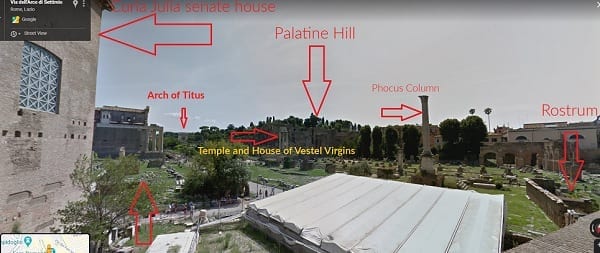
To give you a sense of just how much history is here, even ancient Romans would have looked at this location as a remnant of times that had long since passed.
In modern times, this is the site of both an outdoor and indoor museum that houses archaeological finds from the area. Tickets are included with admission to the Colosseum.
The buildings on Palatine Hill are surprisingly better preserved than those you’ve seen in the Roman Forum.
Mamertine Prison
Located just east of Piazza del Campidoglio, this historic site was once used as a prison, and it’s perhaps best known as the place where Vercingetorix was once held.
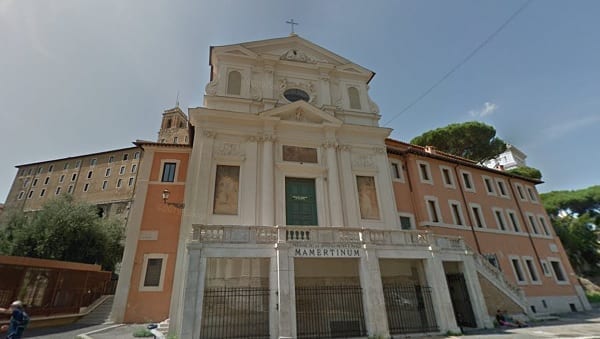
Although most prisoners here were given swift punishment, Vercingetorix underwent a sentence that lasted many years as a result of the civil war following Caesar’s return to Rome.
It is also said that Christian saints Peter and Paul may have been held here, and there is an inscription describing them above the word “Mamertinum.”
Today, there is an altar to Peter and Paul in this former prison.
Forum of Caesar
As the name implies, this forum was designed by Julius Caesar, and it was just one of many things he designed in the Roman Forum.
View of the Forum of Ceasar looking toward the Colosseum
The Forum of Caesar itself is a long, narrow, rectangular stone space that had previously been used for residential real estate.
Much like Roman Forum, this location was used to combine a bunch of different services that brought people together including a temple, shops, offices, and an open meeting place to talk.
This forum was intended to provide additional space for public activities, as the Roman Forum was becoming more crowded and the city needed more room for its growing population.
Trajan’s Column
Built in 113 CE, this column was named after Emperor Trajan, and it is dedicated to his victory in the war against the Dacians.
If you look closely, you can see depictions of the war engraved on this structure.
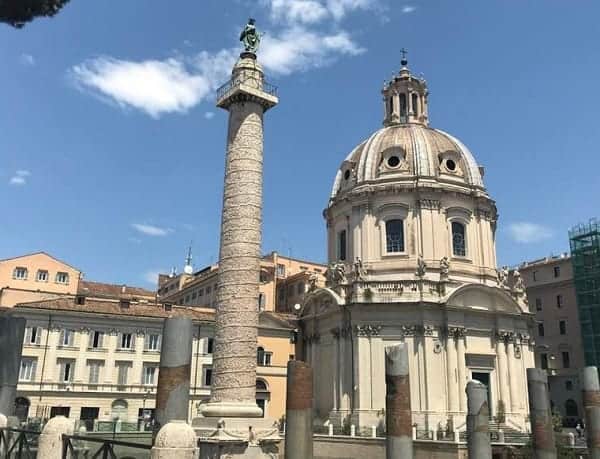
Trajan’s Column was built hollow with a spiral staircase leading to the top.
At almost 40 meters tall, this landmark is about as high as the hillside that they removed to make space for it!
Although the story of the war depicted along its walls is difficult to follow now as it spirals up the entire length, there were once two libraries flanking the column which had viewing platforms where you could see the engravings.
The statue on top was once of Emperor Trajan himself, but it was replaced with a statue of St. Peter many decades ago.
Forum of Trajan
The Trajan Column is just one small part of the greater Forum of Trajan which also contained the two libraries alongside the structure.
This location was also home to Basilica Ulpia, which was the largest church in Rome when it was built.
Just past the church is a 100-metre long public area with porticoes along its edges.
The entire area was given a marble floor and an equestrian statue of Trajan was placed in the center.
The excavation of this area isn’t as complete as other parts of the city.
But, it is thanks to Benito Mussolini that we can even see what we have today, as he was the mastermind behind the excavation of Trajan’s Forum.
Trajan’s Market
This marketplace was actually built into the hillside to keep it from falling, and it has been useful ever since it was originally constructed.
Over the years, Trajan’s Market was used to house both offices of government and commercial shops.
This may have been where ancient Romans picked up the government-supplied grain.
Due to the fact that it’s still in good shape, this is now the site of the Museum of the Imperial Fora, which is full of relics discovered during the excavation of all nearby forums.
Tickets to the museum are usually €11.50, but if they are hosting a special exhibit, you may have to pay €14 for admission which includes that attraction.
Forum of Augustus
When this location was originally designed, it included a colossus of Augustus and a Temple of Mars Ultor.
Pieces of both sites remain, but the artifacts from the colossus are now located at Trajan’s Market.
Sadly, much of this forum has been destroyed or built over, so there isn’t much to see here anymore.
That said, you can still see the back wall of the forum and three columns from its Temple of Mars Ultor.
Like all the other forums in the area, this location was used for civic functions and it was a public site where people could meet and conduct business.
Forum of Nerva
Named after Emperor Nerva, this forum was originally intended for his predecessor Domitian, but work on the structure was only completed after he left office, so Nerva ended up taking the credit.
Although that might not seem fair, it’s perhaps fitting that this is one of the smaller forums in the area, and that’s because three other emperors already had similar sites built nearby before this one was finished.
Even though it’s technically known as the Forum of Nerva, Domitian’s influences can be seen here, as the temple in this area is devoted to Minerva -- Domitian’s protector goddess.
Since it was so narrow, this forum was used mostly as a road during the middle ages.
The newer road in this area covers most of the forum, preventing excavation teams from digging it up.
Forum of Vespasian/Temple of Peace
This entire site is actually the Temple of Peace, which was finished in 75 CE.
However, it has become known as the Forum of Vespasian over the years thanks to its enormous size which was similar to that of a forum.
Originally, the Temple of Peace was built to commemorate the victory of Titus and Vespasian in Judea.
Unlike an actual forum, the floor of this temple was earthen. However, there were long fountains along the sides of the courtyard which was bordered by rose gardens.
In addition to serving as a temple, this area was also used as a civic space with libraries, a medical school, and even a museum once found in the complex.
Today, the Temple of Peace houses parts of a huge marble map of the city as it existed in the early 200s CE.
Basilica of Maxentius
When this church was built, it took over the Basilica Ulpia as the largest basilica in all of Rome.
The full name of this location is actually the Basilica of Maxentius and Constantine.
These two emperors were once enemies on either side of a civil war, and they were two of the most important leaders of their time.
Constantine eventually beat Maxentius in 312 and finished the construction of this church, which was initially being built for Maxentius. As a result, the basilica is dedicated to both men.
The Basilica of Maxentius and Constantine put the construction technology and knowledge of the Romans to the test.
Initially, it housed a colossus statue of Constantine, and there are a few pieces of this structure remaining in the Capitoline Museums.
Arch of Constantine
This arch commemorates Constantine’s victory over Maxentius in 312.
Although it was the largest of Rome’s triumphal arches, its statues and reliefs were taken mostly from other monuments in the city.
Both sides of the arch have statues made in the era of Trajan and medallions made in the era of Hadrian.
The reliefs do depict the events of his war with Maxentius, but the level of detail put into the artwork was nowhere near the same quality as you would expect from most earlier works in Rome.
Arch of Titus
Much like the Temple of Peace, this arch was also built to commemorate the victory of Titus and Vespasian in Judea.
The arch depicts scenes from this victory, including the theft of a menorah which would eventually be displayed in the Temple of Peace.
Unfortunately, the events depicted are also part of a long history of mistreatment of the Jewish people which resulted in the Diaspora.
For many centuries, Rome’s Jewish population would be subject to various taxes, forced to worship at Christian churches, and confined to the location known as the Jewish Ghetto.
If you’re interested in learning more about this area, consider taking out the Jewish Ghetto self-guided tour.
The Colosseum
Named after the colossus of Nero which once existed here, this location was originally known as the Flavian Amphitheatre, named after the Flavian dynasty of Vespasian, Titus, and Domitian.
This was the largest arena in the world at the time it was built, and it is one of the seven wonders of the world.
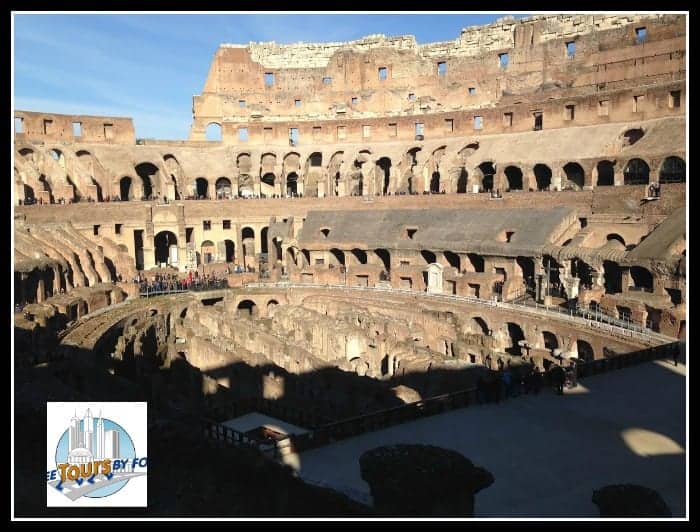
Although only a third of the original structure still remains, it’s still quite impressive to this day.
The Colosseum was used for multiple events including gladiatorial combat, naval battles, and more.
Today, you can purchase tickets to enter the Colosseum and get a good look at its interior. Tickets also include admission to the Roman Forum and Palatine Hill.
To learn more, check our post about visiting the Colosseum.






